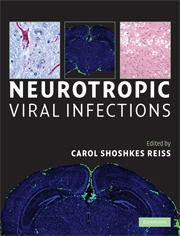Book contents
- Frontmatter
- Contents
- List of contributors
- Foreword
- Preface and acknowledgments
- Section I Introduction: RNA viruses
- Section II Introduction: retroviruses, DNA viruses, and prions
- Section III Introduction: immunity, diagnosis, vector, and beneficial uses of neurotropic viruses
- 14 Innate immunity in viral encephalitis
- 15 Role of Toll-like receptors in neurotropic viral infections
- 16 Neuroendocrine-immune interactions in neurotropic viral infections
- 17 Epidemiology of viral encephalitis
- 18 Pathogen surveillance and discovery
- 19 Clinical management of viral encephalitis
- 20 Influences of arthropod vectors on encephalitic arboviruses
- 21 The role of bats as reservoir hosts of emerging neurological viruses
- 22 Viral oncolysis of glioblastoma
- 23 Viral gene therapy for central nervous system diseases
- Index
- Plate section
- References
18 - Pathogen surveillance and discovery
from Section III - Introduction: immunity, diagnosis, vector, and beneficial uses of neurotropic viruses
Published online by Cambridge University Press: 22 August 2009
- Frontmatter
- Contents
- List of contributors
- Foreword
- Preface and acknowledgments
- Section I Introduction: RNA viruses
- Section II Introduction: retroviruses, DNA viruses, and prions
- Section III Introduction: immunity, diagnosis, vector, and beneficial uses of neurotropic viruses
- 14 Innate immunity in viral encephalitis
- 15 Role of Toll-like receptors in neurotropic viral infections
- 16 Neuroendocrine-immune interactions in neurotropic viral infections
- 17 Epidemiology of viral encephalitis
- 18 Pathogen surveillance and discovery
- 19 Clinical management of viral encephalitis
- 20 Influences of arthropod vectors on encephalitic arboviruses
- 21 The role of bats as reservoir hosts of emerging neurological viruses
- 22 Viral oncolysis of glioblastoma
- 23 Viral gene therapy for central nervous system diseases
- Index
- Plate section
- References
Summary
Introduction
This chapter will describe methods and perspectives for pathogen discovery and surveillance, provide vignettes from our own experience that illustrate the complexity of pursuing research in this arena and the process that led to the implementation of particular strategies, and discuss challenges associated with proving causality.
Proof of causation
Discovery of an organism in association with disease is only the first step in understanding its role in pathogenesis. Many have wrestled with the challenge of codifying the process of proving causation. The germ theory of disease formulated by Pasteur, Koch, and Loeffler proposed precise criteria that define a causative relationship between agent and disease: the agent should be present in every case of a disease, it should be specific for a disease (i.e., present in none other); it should be propagated in culture and proven capable of causing the same disease upon inoculation into a naïve host. Known as Koch's postulates [1], these criteria were subsequently modified by Rivers for specific application to viruses [2] and by Fredericks and Relman to reflect the advent of molecular methods [3] (Table 18.1). Koch's postulates remain the ideal standard by which causality is considered to be proven. However, there are problems with holding to this standard. Some agents cannot be propagated in culture. Additionally, for many human viral pathogens there may be no animal model.
- Type
- Chapter
- Information
- Neurotropic Viral Infections , pp. 334 - 346Publisher: Cambridge University PressPrint publication year: 2008



